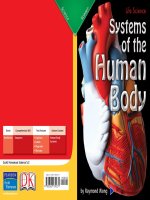- Trang chủ >>
- THPT Quốc Gia >>
- Hóa
Systems of the body
Bạn đang xem bản rút gọn của tài liệu. Xem và tải ngay bản đầy đủ của tài liệu tại đây (4.75 MB, 14 trang )
Genre
Nonfiction
Comprehension Skill
Cause and Effect
Text Features
• Captions
• Charts
• Glossary
Science Content
Body Systems
Scott Foresman Science 6.4
ISBN 0-328-13980-7
ì<(sk$m)=bdjiae< +^-Ä-U-Ä-U
Vocabulary
alveoli
antibody
endocrine gland
enzyme
hormone
impulse
neuron
pathogen
What did you learn?
1. How can you help the cells in your body to
work properly?
2. Starting with the heart, describe the route that
blood takes through the body when moving to
provide your body with oxygen and nutrients.
Name the specific types of blood vessels.
by Kara
Black with
3. Describe the way neurons
communicate
other neurons.
Picture Credits
Every effort has been made to secure permission and provide appropriate credit for photographic material.
The publisher deeply regrets any omission and pledges to correct errors called to its attention in subsequent editions.
Photo locators denoted as follows: Top (T), Center (C), Bottom (B), Left (L), Right (R), Background (Bkgd).
6 (TR) Gladden Willis, M.D./Visuals Unlimited; 7 (TL) VVG/Photo Researchers, Inc.;
10 (BR) Science Photo Library/Photo Researchers, Inc.; 20 SPL/Photo Researchers, Inc.
Unless otherwise acknowledged, all photographs are the copyright © of Dorling Kindersley, a division of Pearson.
ISBN: 0-328-13980-7
Copyright © Pearson Education, Inc. All Rights Reserved. Printed in the United States of America.
This publication is protected by Copyright, and permission should be obtained from the publisher prior to any
prohibited reproduction, storage in a retrieval system, or transmission in any form by any means, electronic,
mechanical, photocopying, recording, or likewise. For information regarding permission(s), write to
Permissions Department, Scott Foresman, 1900 East Lake Avenue, Glenview, Illinois 60025.
3 4 5 6 7 8 9 10 V010 13 12 11 10 09 08 07 06 05
4.
Your endocrine system
releases hormones in order to control many of
your body’s functions. Write to explain how a
biofeedback loop mechanism works to regulate
the release of hormones.
5.
Cause and Effect When pathogens enter
your body, they cause your immune system to
react. Describe your immune system’s response
to the attackers.
How is the body
organized?
vacuole
mitochondrion
Cells Working Together
Your body is composed of more than 75 trillion cells, all
working together to help your body grow and sustain itself. Each
cell is a living unit that is capable of taking in food, getting rid
of waste, and reproducing. Some cells, such as the cells in the
liver and skin, live for only a few days and continuously replace
themselves. Brain cells, however, do not replace themselves.
Specialized cells have a particular size and shape. Their form
depends on the function they perform. Different types of cells are
organized into specific groups known as tissues. Muscle and bone
are different types of tissue. Organs are structures made up of two
or more different tissue types, and each organ performs a certain
function within your body’s systems. Your cells are constantly
communicating with each other to meet your body’s needs and
make it work efficiently.
A cell is composed of molecules, which are nonliving and
made up of atoms. The cell is made up of several kinds of
molecules, including proteins, nucleic acids, carbohydrates, and
lipids. These all have a specific role in the cell’s function and form
organelles within the cell. Organelles are like tiny organs that
do specific jobs within the cells. For example, mitochondria are
organelles that convert nutrients into energy for the cell.
The nucleus is the largest organelle in a cell. It contains
deoxyribonucleic acid (DNA) and ribonucleic acid (RNA).
These two forms of nucleic acid contain the cell’s hereditary
information. Lysomes are small organs that recycle molecules and
dispose of waste.
2
cell
nucleus
cell membrane
3
What systems help
move body parts?
Skeletal System
Your skeleton is made up
of 206 bones, and it works with
muscles to make the body move.
The largest bone in your body is
the thighbone, and the smallest
bone is the stirrup bone, found
in your ear. Bones are composed
of living tissues and nonliving
substances. The inside of bones
is soft and contains bone marrow,
where red blood cells, white blood
cells, and blood platelets are
formed. Bones perform several
functions. They support your body,
protect your internal organs, and
store minerals such as calcium.
Your skeletal system can suffer
from different diseases, such as
arthritis and osteoporosis. Arthritis
causes joints to become swollen and
painful. This condition can affect
people of all ages. Osteoporosis is a
condition that occurs usually later
in life, when bones become brittle
and weak. It occurs when people do
not get enough calcium in their diet
to keep their bones healthy.
4
pivot joint
hinge joint
ball-andsocket joint
A joint is formed when two or
more bones come together. There
are three major types of moving
joints: ball-and-socket joints,
hinge joints, and pivot joints.
Some joints, such as the ones in
your skull, do not move. Joints
that do move are connected by
tough tissues known as ligaments.
Another type of connective tissue
is cartilage, which covers the ends
of bones at joints. Cartilage is
softer and more flexible than bone
and protects bones where they
rub together.
5
Muscular System
More than six hundred muscles form your muscular system
and work with your skeletal system to make your body move
and function. There are three kinds of muscular tissue: smooth
muscle, cardiac muscle, and skeletal muscle. Your muscle tissue
makes up 40 to 50 percent of your body weight.
Smooth muscles are involuntary muscles. They are found
in the organs of the digestive system and in blood vessels.
Involuntary muscles operate automatically to control parts of
the body.
Cardiac muscle is another type of involuntary muscle. This
muscle is located only in your heart and contracts automatically to
move blood through the chambers of the heart.
Skeletal muscles are known as voluntary muscles because they
are the only kind of muscle you can consciously control. Skeletal
muscles are attached to the skeleton. They do the work of moving
your body.
cardiac muscle
magnified image of
cardiac muscle
smooth muscle
magnified image of
smooth muscle
6
skeletal muscle
magnified image of
skeletal muscle
7
How do systems
control the body?
thalamus
hypothalamus
cerebrum
cerebral cortex
Nervous System
Your nervous system includes
the brain, the spinal cord, nerves,
and sense organs. Information is
constantly collected and processed
by the nervous system, and your
body responds consciously
and unconsciously to this
information. Your brain and
spinal cord are connected to
nerves that send and receive
information from one body
part to another.
Your brain has several
parts that control specific
functions: the brain stem,
the cerebrum, and the
cerebellum. The brain
stem and cerebellum help
regulate many functions
of your body automatically.
Your heartbeat, respiration,
and digestion are maintained by
the brain stem. The cerebellum
controls your balance and posture.
The cerebrum interprets information
gathered by your senses and controls
conscious thought.
8
pituitary gland
brain stem
cerebellum
spinal cord
the brain
the nervous
system
Your nervous system controls and regulates many of your
body’s systems, so it is important that you protect it from harm.
You should always wear a helmet when riding a bicycle and wear a
seatbelt when riding in a car. Certain sports, such as football and
ice hockey, require players to wear special equipment to protect
the brain. Your nervous system may also be affected by different
kinds of bacteria, parasites, or viruses.
9
cell body
nucleus
dendrite
node of
Ranvier
myelin sheath
synaptic
knobs
axon terminal
fiber
mitochondria
axon
Nerve cells, or neurons, transmit
messages throughout your body. Neurons
consist of a cell body with branching
parts. Dendrites are the short branches
that receive messages from other neurons
and carry them to the cell body. An axon
is a long branch that transmits messages to
other neurons. There is a chemical change,
which triggers an impulse. Nerve impulses
travel from the axon of one neuron to the
dendrites of another neuron.
Most impulses are processed by your
brain, which interprets this information
and tells your body what to do. However,
your body can automatically react to some
things. This reaction, or reflex, helps protect
the body from dangerous situations. For
example, the doctor may check to see if your
reflexes are working properly by tapping
your knee lightly, making your leg kick out.
Tapping the kneecap tendon stimulates a sensory
nerve in the thigh muscle, which transmits a signal
to the spinal cord. Motor nerve fibers relay the
signal back to the muscle, making the leg kick out.
thigh muscle
kneecap
sensory
nerve fiber
stimulus
structure of a neuron
kneecap
tendon
nerve
spinal cord
a group of neurons
10
motor
nerve fiber
11
Endocrine System
Biofeedback Loop
parathyroid
gland
brain
thyroid gland
pituitary
gland
pancreas
adrenal gland
Testes are
the glands
that
produce
male
hormones.
ovary
The endocrine system is composed of specialized body tissues
and organs known as endocrine glands. These glands influence
body growth, body reactions, reproductive functions, and
metabolism.
Endocrine glands release chemical substances called
hormones directly into the bloodstream in order to achieve
balance throughout your body. Hormones travel to specific target
cells in the body and inform the cells to carry out a certain task.
In most cases only a small amount of a hormone is released to
bring about the intended result.
12
Endocrine glands constantly regulate substances in the
body to keep them in balance. The glands release more or fewer
hormones, depending on the need.
Hormone levels are regulated by a biofeedback loop. A
biofeedback loop functions by constantly sending information
back and forth throughout the body. The endocrine glands release
hormones when needed and stop releasing hormones when they
are not needed. The thermostat in your home functions in a
similar way. The thermostat is set to a specific temperature, and
when it gets too cold, the heat turns on. When the temperature
in your home reaches the temperature set on the thermostat, the
heat turns off.
Endocrine
Gland
Function
Pituitary
Controls development and body growth:
controls the thyroid, ovaries, testes, and
other glands
Thyroid
Controls how cells release energy
Parathyroid
Controls the amount of calcium and
phosphorus in the blood
Adrenals
Control the body’s reaction to anger, fright,
or fear
Pancreas
Controls amount of glucose in the blood
Ovaries
Control female characteristics and the
menstrual cycle
Testes
Control male characteristics
13
How do
systems
transport
materials?
Digestive System
Your digestive system
breaks down nutrients from
your food into a simpler form
that can be used by your cells.
Cells use these nutrients for
energy to grow and repair
themselves.
There are two phases of
digestion: mechanical digestion
and chemical digestion. During
mechanical digestion, your
teeth and mouth break food
down into smaller pieces, but
your body still cannot absorb
them. An enzyme is a protein
produced in cells that helps
speed up chemical reactions.
During chemical digestion,
enzymes and acids break
food down into molecules
that can be absorbed into the
bloodstream.
14
mouth
Digestion begins
in the mouth,
where teeth
shred food.
Salivary glands
produce saliva,
which starts
the chemical
breakdown
of food.
Your stomach performs both
mechanical and chemical digestion. The
stomach is a muscular sac that physically
squeezes food about three times per minute.
It also secretes enzymes and acid that
chemically digest the food particles.
Your digestive system requires regular
care to run smoothly, and your body
needs good nutrition to function properly.
Eating fiber helps keep the digestive system
working properly. Fruits, vegetables, and
whole grains are all good sources of fiber.
Drinking plenty of water is essential, and
you should avoid overeating. Your teeth
also need regular checkups by a dentist.
esophagus
liver
The liver produces bile,
which helps digest fat.
gall bladder
Bile produced by the
liver is stored in the
gall bladder until it
is needed.
large
intestine
The large intestine
absorbs water from
undigested food
and stores solid
wastes until they
leave the body via
the anus.
After food has been chewed, the tongue
pushes it into the esophagus. Muscular
contractions then propel the food toward
the stomach.
stomach
Glands in the stomach produce enzymes
that continue the breakdown of food.
pancreas
The pancreas produces enzymes that flow
into the small intestine.
small intestine
Most digestion and absorption takes place in
the small intestine.
anus
15
Circulatory System
The circulatory system is made up of blood,
the heart, and blood vessels. It transports nutrients
and oxygen throughout your body and carries away
wastes. Blood is made up of plasma and three kinds
of cells: red blood cells, white blood cells, and
platelets. Plasma is the liquid part of the blood that
carries these materials, and it is mostly water. Red
blood cells bring oxygen to parts of your body, white
blood cells help your body fight diseases, and platelets
help your blood clot if you get a cut.
There are three types of blood
vessels in your circulatory system.
Blood is carried away from the heart
by arteries and is carried toward the
heart by veins. The smallest blood
oxygenated
vessels are called capillaries. These
blood
vessels are so thin that oxygen and
nutrients can pass right through
their walls and into body tissues.
Carbon dioxide and other wastes are
removed from tissues by capillaries
in the same way.
The circulatory system helps to
regulate your body’s temperature.
When your body gets too hot,
blood vessels near the skin enlarge
to get rid of heat. When your body
is cold, the blood vessels conserve
heat by contracting.
16
Blood comes
from the
lungs.
Blood is
pumped to
the lungs.
right
pump
left
pump
separating
muscle
deoxygenated
blood
The heart pumps blood to the
arteries, and the arteries lead to
smaller vessels known as arterioles.
These vessels continue to become
smaller until they form capillaries.
The capillaries deliver materials
to the tissues and remove the wastes,
and the blood begins its journey
back to the heart. Your capillaries
join together to form small veins
called venules, and those vessels
merge together to become larger and
larger veins that lead to the heart.
17
Respiratory System
Your respiratory system brings oxygen to all parts of your
body and carries away carbon dioxide. Cells require oxygen
to release energy, and carbon dioxide is produced as waste.
Your nose, trachea, bronchial tubes, and lungs make up your
respiratory system.
trachea
alveoli
capillary
During respiration, you breathe in air through your nose
and throat. They make up the upper respiratory tract. The lower
respiratory tract starts with the larynx, or voice box, and the
trachea, or windpipe. The trachea splits into two branches called
bronchi. The bronchi split into small branches, or bronchioles.
In the lungs, the bronchioles eventually end in tiny sacs called
alveoli. Alveoli are where oxygen and carbon dioxide are
exchanged in the blood, and there are about 150 million
alveoli in each lung. They are arranged in clusters, like
grapes, and are surrounded by capillaries. Blood vessels
move oxygen from the lungs to the heart. The
heart pumps this oxygen throughout the body
through smaller and smaller blood vessels. The
same process happens in reverse to eliminate
carbon dioxide from the body. Cells expel
carbon dioxide into the bloodstream, and
the carbon dioxide is carried to the heart,
then the lungs, and finally exhaled.
Lungs are not made up of muscle
tissue, so they cannot contract on their
own. They rely on the diaphragm to
help them. When your diaphragm
contracts, your lungs fill with air,
and when the diaphragm relaxes,
you exhale.
ribs
bronchioles
18
bronchi
diaphragm
19
How do systems
keep the body
healthy?
A white blood cell surrounds
and destroys a group of
pathogens.
Immune System
Your body must defend itself against foreign
bodies that may cause disease, such as bacteria,
viruses, and fungi. These organisms are known
as pathogens. Your body depends on its
immune system to repel pathogens and keep
you healthy.
There are two types of immunity: innate
immunity and adaptive immunity. Innate
immunity, also known as nonspecific immunity,
works to keep pathogens from entering your body.
Your skin prevents pathogens from entering your
body. Tears wash pathogens out of your eyes and also
have chemicals that kill harmful organisms. Your nose,
mouth, and throat produce mucus that catches pathogens,
and your stomach secretes chemicals that kill pathogens.
If harmful organisms happen to get past these defenses,
your immune system develops specific defenses. This is known
as adaptive immunity, because your body adapts to the threat
to fight it.
Adaptive immunity only responds after a harmful organism
is detected. It responds to each specific pathogen. Adaptive
immunity also recognizes pathogens that have
invaded the body in the past and protects your
body against them.
20
This is why most people
only get chicken pox once
during their life. This same
principle is at work when
you receive immunization
shots from your doctor.
After a pathogen enters
the body, lots of white blood cells are
created. Body cells that have been infected by
the pathogen are attacked by the white blood cells.
At the same time, other types of white blood cells
are directed to produce antibodies. Antibodies are
chemicals that destroy pathogens.
21
Systems Working Together
All the systems in your body work hard to keep you alive
and healthy. When you are exercising, your respiratory and
circulatory systems work harder. Your heart pumps faster to
bring more nutrients and oxygen to the cells in your muscles.
Your amazing body runs without stopping every minute of
your life. It does such a good job and runs so smoothly that you
might forget that you also need to take care of it on a daily basis.
Your immune system works to rid your body of pathogens.
White blood cells produce chemicals called antibodies in order
to kill pathogens that enter your body. Still, you need to take
responsibility for your own health.
Good health habits start early in life. Developing good health
habits now can help you stay healthy. Food is very important to
keep your body nourished, so eat a well-balanced diet and drink
plenty of water. Keep your body fit by exercising regularly. Rest
and sleep enough so your body can recover.
When playing sports, protect
yourself from physical harm by wearing
the required protective gear. Practice
good cleaning habits. Wash your
hands often. Regular physical
checkups can help your doctor
to detect any potential health
problems.
22
23
Vocabulary
Glossary
alveoli
antibody
endocrine gland
alveoli
tiny sacs at the end of bronchioles, where oxygen
enzyme
enters the blood and carbon dioxide is removed
hormone
impulse
antibody
a chemical produced by white blood cells that kills
neuron
specific pathogens
pathogen
endocrine
gland
an organ that releases chemical substances directly
into the blood
enzyme
a protein that breaks food down into nutrients that
can be used by the body
hormone
substance released by the endocrine glands that
control many of the body’s functions
impulse
a message that travels from an axon of one neuron
to the dendrite of another neuron
neuron
a nerve cell forming part of a network that passes
messages throughout your body
Picture Credits
Every effort has been made to secure permission and provide appropriate credit for photographic material.
The publisher deeply regrets any omission and pledges to correct errors called to its attention in subsequent editions.
pathogen
an organism that causes disease
Photo locators denoted as follows: Top (T), Center (C), Bottom (B), Left (L), Right (R), Background (Bkgd).
6 (TR) Gladden Willis, M.D./Visuals Unlimited; 7 (TL) VVG/Photo Researchers, Inc.;
10 (BR) Science Photo Library/Photo Researchers, Inc.; 20 SPL/Photo Researchers, Inc.
Unless otherwise acknowledged, all photographs are the copyright © of Dorling Kindersley, a division of Pearson.
ISBN: 0-328-13980-7
Copyright © Pearson Education, Inc. All Rights Reserved. Printed in the United States of America.
This publication is protected by Copyright, and permission should be obtained from the publisher prior to any
prohibited reproduction, storage in a retrieval system, or transmission in any form by any means, electronic,
mechanical, photocopying, recording, or likewise. For information regarding permission(s), write to
Permissions Department, Scott Foresman, 1900 East Lake Avenue, Glenview, Illinois 60025.
3 4 5 6 7 8 9 10 V010 13 12 11 10 09 08 07 06 05
24
What did you learn?
1. How can you help the cells in your body to
work properly?
2. Starting with the heart, describe the route that
blood takes through the body when moving to
provide your body with oxygen and nutrients.
Name the specific types of blood vessels.
3. Describe the way neurons communicate with
other neurons.
4.
Your endocrine system
releases hormones in order to control many of
your body’s functions. Write to explain how a
biofeedback loop mechanism works to regulate
the release of hormones.
5.
Cause and Effect When pathogens enter
your body, they cause your immune system to
react. Describe your immune system’s response
to the attackers.









